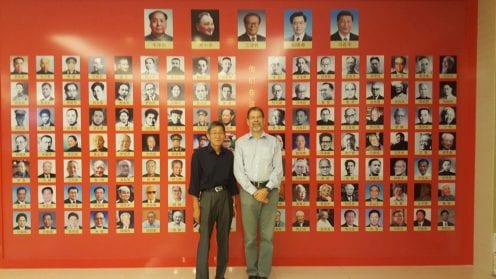Today’s guest blog is by Xinyuan Wang, author of Social Media in Industrial China
In recent decades China has witnessed the largest ever migration in human history. By 2015 the number of Chinese people who had left rural villages to work in factories and cities had risen to 277 million. If Chinese migrant workers were the population of a country, it would be the fourth largest in the world, and they are the human faces behind ‘Made-in-China’. While ‘Made-in-China’ products have become pervasive in our daily life, the people who produce them remain mysterious; however, a new open access book Social Media in Industrial China, reveals that Chinese factory workers actually exhibit an unexpected and sophisticated use of social media to bridge the gap between their rural roots and their industrial lives.
Xinyuan Wang, the author of the book, is a digital anthropologist from UCL who spent 15 months undertaking fieldwork in a small factory town in southeast China, living in one of the factories and tracking the use of social media. By studying this marginalized population, who have, in many ways, embraced the potential of social media to the fullest, this in-depth study sheds light not just on Chinese social media usage, but also on the nature of contemporary China.
Homeland on social media
Hua, a factory worker in her early 30s, has a strong emotional attachment to the beautiful mountain that frames her home village. During her periods as a factory worker, she misses her home village terribly. Her account on the Chinese social media platform QQ is rich in images of her home village; she has uploaded a large number of photographs of her home village into an album called ‘homeland’ (jiaxiang).
Curiously, however, when asked whether she plans to move back to her home village, Hua’s answer is always negative. As well as a lack of job opportunities there, she also feels that her exposure to modern China means that she can no longer go back to ’boring and backward’ country life.
’Sometimes, when I felt sad or deflated, I will have a look at those photos … as if I visited my homeland,’ Hua said.
The homeland album is very popular among Chinese migrant workers, and most of them admitted that, even though they miss their home village, they felt unable to return after their exposure to the realities of modern China.
These rural migrants are often referred to as a ‘floating population’ — the hukou (household registration) policy implemented by the government means that they are unable to create a permanent home in the city. A consequence of this is that they are constantly looking for temporary employment, unable to settle in a single place. Hukou policy divides the Chinese population into rural or urban residents dependent on their place of birth and allocates social resources accordingly, which means rural migrants are unable to enjoy the social welfare benefits that their counterparts in cities receive.
Even when faced with rural-urban divide and severe social discrimination, rural migrants, especially the younger generation, still regard migrating to urban areas as the only way to participate in modern life, and rural life is seen as ‘backward’ and ‘boring’. In this situation, people’s attitude towards their homeland is very ambiguous.
‘Home village is a place you always miss, but not really a place you want to return to,’ as Hua said. Like Hua, many rural migrants see their home village more as a spiritual comfort than a practical option. On social media, all the bad memories and negative associations of village life and homeland seemed to be expunged, leaving only ideal, purified images that give people comfort. They may not be physically in the villages of their origin but, wherever the floating rural migrants are, they take their homeland with them.
However, homeland is not the only place that is rebuilt on social media. To many, social media is also where they actually live, as Xinyuan argues in her book.
‘Life outside the smartphone is unbearable’
Lily, a 19-year-old factory girl, spends almost every single waking hour on QQ when she is working on the factory assembly line. Lily’s QQ profile is a stylish, curated space with lots of beautiful photos and pop music that she has collected online. Online, Lily is popular and she talks as if she were a princess who is waiting for true love: “In my life I have always dreamt about my true love. He will treat me very well, protect me from all the uncertainty, displacement, sadness, and loneliness. However, I always know that that person will never turn up.” However, Lily never talks in this manner offline.
Lily lives with her parents and younger brother and sister in a small factory town. They live in two small single rooms without heating, hot water or air conditioning; they share the only toilet with two other rural migrant families. In summer, when indoor temperatures regularly pass 38°C, the family wash themselves in the shared bathroom; a plastic bucket and washbasin function as a shower. The walls are heavily stained, and there is soiled toilet paper and stagnant water on the floor. In winter, when temperatures fall below freezing, the family head to a nearby public bath to shower once a week.
One day after work Lily was ‘working with’ her QQ via a smartphone, a Huawei model that she had purchased for 1,850 RMB (US$308). Captivated and absorbed by her ‘online world’, she eventually looked up and saw Xinyuan.
‘Life outside the mobile phone is unbearable, huh?’ Lily observed.
Lily’s insight forced Xinyuan to address the question that became central to her work in industrial China: where do people live? In this small factory town, Xinyuan has met many young rural migrants who have moved geographically closer to a modern China, but it appears that it is only online that they actually arrive there. For many migrant workers, social media has become the place where they can visualise and, in a way, achieve their aspiration towards modernity. On a wider scale, Xinyuan’s study witnessed not just rural-urban migration, but also a parallel migration from offline to online.
The study demonstrates the need to understand where people live, without assuming that the offline is necessarily more ‘real’ or more material. Whilst people in the West have become concerned about the authenticity of social connections on social media, for some migrant workers the situation is the opposite — it is online where they have found the most genuine relationships, even with strangers. The story of Feige, a 37-year-old forklift truck driver, presents a typical example.
‘Purer’ relationships on social media
Feige is a member of 15 QQ groups, though he only actively participates in three. Members of these groups are, on the whole, factory workers with backgrounds similar to Feige’s. Though he had never met the members of these groups offline, they seemed to know much more about him than his colleagues. Feige is extremely popular amongst his online friends. Members of the groups have great affection for him, finding him funny and smart, and always asking for his opinions on social events and news.
‘They [online friends] like me and talk with me because they really like me, not because I am rich so that they can borrow money from me, or I am powerful so that they can get a job from me. Here everything is much purer, without power and money involved,’ Feige explained.
Feige regards his online friendships as ‘purer’ (geng chun) than his offline relationships, as online there are no pragmatic concerns involved. That friendship on social media has been valued highly by Feige is not rare among rural migrants; for migrant workers such as him, who are often frustrated by their social status, social media provides new possibilities of sociality free from social hierarchy and discrimination.
It is on social media where Chinese migrant workers have experienced a real sense of ‘friendship’; in offline situations, kinship and regional relationships, such as between fellow villagers, are dominant. It is interesting to note that, rather than being the threat to privacy that many in the Western world perceive, social media has actually increased the experience of privacy for most migrant workers. In an environment where offline private space is usually limited, and any effort of avoiding the public gaze can be misinterpreted and stigmatized as an attempt to cover something shameful, the online world offers people much needed personal space and freedom.
The stories of Lily and Feige are just two examples from Social Media in Industrial China; Xinyuan’s field work provides many more absorbing accounts of how social media impacts the lives of rural migrants. Using these real-life tales as a basis, the book illustrates the social media landscape in China and explores the impact of social media on people’s lives. From personal development, social relationships, gender and education, to commerce, privacy, ancestor and deity worshipping and political participation, many of Xinyuan’s discoveries challenge the West’s perception of both China and its inhabitants, explaining why it is time to reassess exactly what we think we know about China and the evolving role of social media.
About Xinyuan Wang
Xinyuan Wang is a PhD candidate at the Dept. of Anthropology at UCL. She obtained her MSc from the UCL’s Digital Anthropology Programme. She is an artist in Chinese traditional painting and calligraphy. She translated (Horst and Miller Eds.) Digital Anthropology into Chinese and contributed a piece on Digital Anthropology in China. A fuller version of this piece appeared on Medium.
If you like what you’ve just read, then we’d recommend that you download Social Media in Industrial China by Xinyuan Wang which is available to download for free here.
Filed under Guest Posts, Open Access, Topical
Tags: Anthropology, Books, China, Guest Post, Internet, Open Access, Popular Culture, Social Media, Society, Topical, UCL Press, Urban Studies, Web Science, Why We Post
No Comments »
 Close
Close









